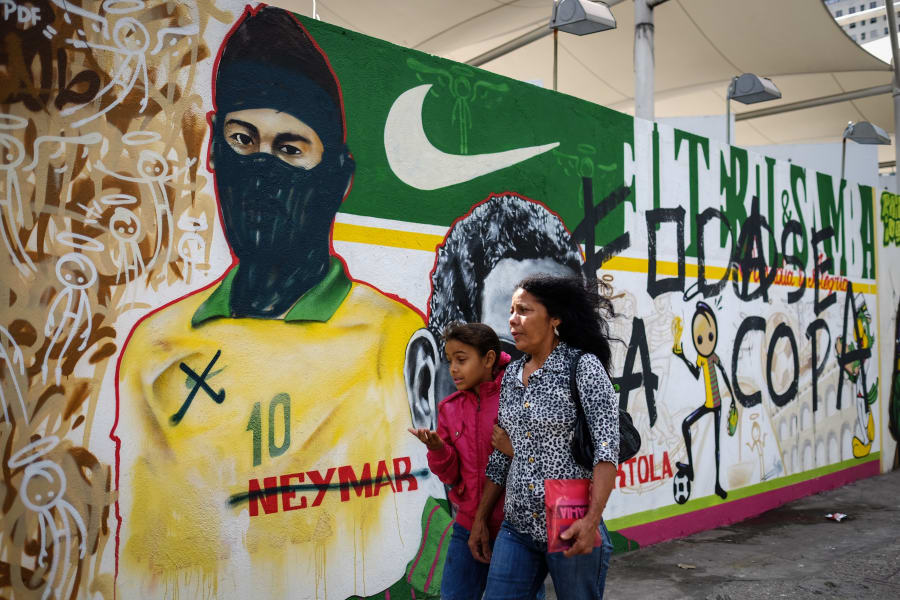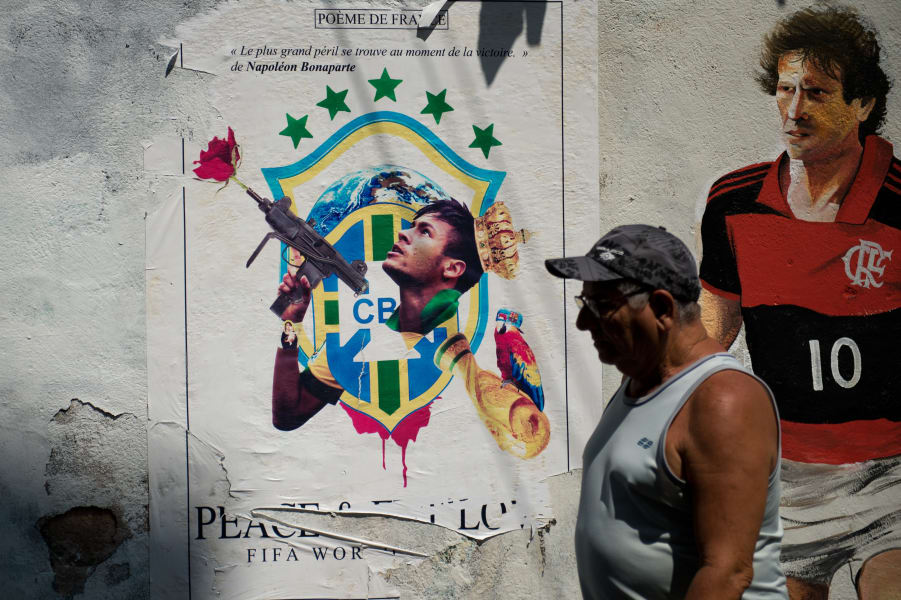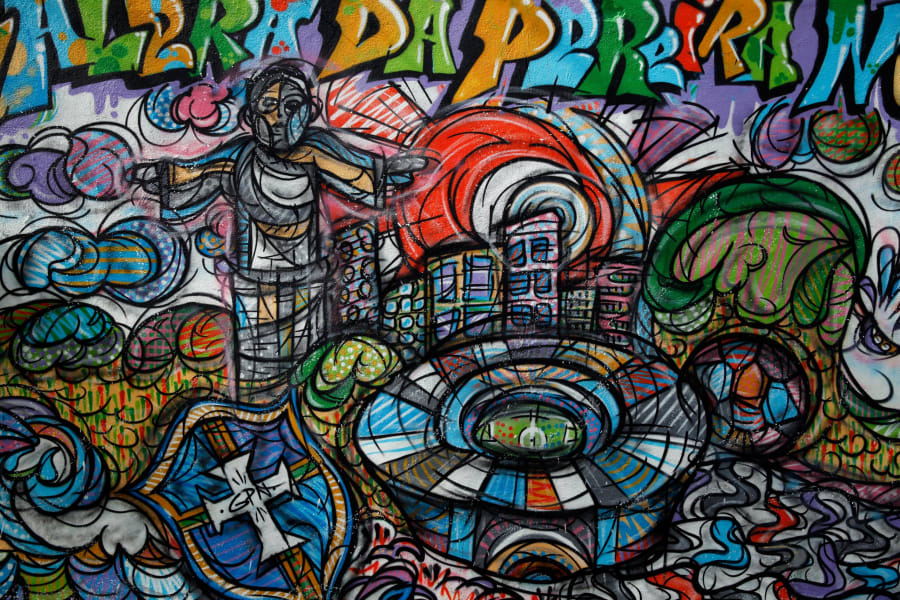Football
World Cup: The art of protest -- Brazil's graffiti artists tackle Brazil 2014
Updated 1142 GMT (1942 HKT) June 27, 2014
Share


1 of 18
If graffiti is the voice of the street, what better way to take a nation's pulse than by gazing upon the walls of its inner cities?
In Brazil, like many nations, graffiti has long been a way for urban artists to decorate their neighborhoods, voice an opinion or tag prominent buildings with their signature style.
As the 2014 World Cup approached, however, many works began to take on the role of a complex social commentary.
Like the diverse spectrum of emotions and opinions surrounding the hosting of the event itself, graffiti appeared that was both aggressive and welcoming; political yet playful.
Brazilians love their football after all -- as evidenced by the passion displayed inside stadia throughout the World Cup so far -- but many remain appalled by the amount of money being spent to host the tournament.
We asked Cranio and Paulo Ito, two prolific graffiti artists from Sao Paulo, to explain how the sentiment of the Brazilian street has impacted their work and been transported onto walls and buildings across the vast country.
Interviews and captions by Eoghan Macguire, for CNN Courtesy Cranio
In Brazil, like many nations, graffiti has long been a way for urban artists to decorate their neighborhoods, voice an opinion or tag prominent buildings with their signature style.
As the 2014 World Cup approached, however, many works began to take on the role of a complex social commentary.
Like the diverse spectrum of emotions and opinions surrounding the hosting of the event itself, graffiti appeared that was both aggressive and welcoming; political yet playful.
Brazilians love their football after all -- as evidenced by the passion displayed inside stadia throughout the World Cup so far -- but many remain appalled by the amount of money being spent to host the tournament.
We asked Cranio and Paulo Ito, two prolific graffiti artists from Sao Paulo, to explain how the sentiment of the Brazilian street has impacted their work and been transported onto walls and buildings across the vast country.
Interviews and captions by Eoghan Macguire, for CNN Courtesy Cranio
A poster of Brazilian poster boy Neymar after being hijacked by graffiti artists shows the striker holding a machine gun with a rose sprouting from the barrel.
Views of graffiti in Brazil differ widely but it is generally not something that is frowned upon by the authorities as it can be in other countries.
"It's easy to paint in cities like Sao Paulo because there is lots of space," said Cranio. "The police don't usually stop people because they think the art is nicer than the blank or white space." Christophe Simon/afp/getty images
Views of graffiti in Brazil differ widely but it is generally not something that is frowned upon by the authorities as it can be in other countries.
"It's easy to paint in cities like Sao Paulo because there is lots of space," said Cranio. "The police don't usually stop people because they think the art is nicer than the blank or white space." Christophe Simon/afp/getty images
Anger around the hosting of the World Cup, however, has pushed an increasing number of artists and protesters to "try to do something with ... a more critical view," said Paulo Ito.
Here, a member of the MPL 'Free Pass Movement' sprays graffiti during a protest for free transportation. Victor Moriyama/Getty Images
Here, a member of the MPL 'Free Pass Movement' sprays graffiti during a protest for free transportation. Victor Moriyama/Getty Images
Brazil witnessed mass protests, strikes and violent clashes between activists and police during the 2013 Confederations Cup and in the run up to the World Cup this year.
The frustration behind this discord was something Cranio wanted to capture.
"For many people the World Cup is no good," Cranio said. "They don't have hospitals, schools, transport, everything is bad but they are putting a lot of money towards the World Cup.
"This is an intervention with the World Cup theme. I'm trying to say what I think through the paintings." Courtesy Cranio
The frustration behind this discord was something Cranio wanted to capture.
"For many people the World Cup is no good," Cranio said. "They don't have hospitals, schools, transport, everything is bad but they are putting a lot of money towards the World Cup.
"This is an intervention with the World Cup theme. I'm trying to say what I think through the paintings." Courtesy Cranio
Ito, meanwhile, achieved international fame with this image of a starving child being presented with a football after it was carried by several major news organizations.
"I was trying to talk about football at the moment of the FIFA Cup,"said Ito.
"I never say (the World Cup) is a bad thing at all but there are problems, like relocating people to live in other neighborhoods and particularly I don't agree with the way FIFA operates." Victor Moriyama/afp/getty images
"I was trying to talk about football at the moment of the FIFA Cup,"said Ito.
"I never say (the World Cup) is a bad thing at all but there are problems, like relocating people to live in other neighborhoods and particularly I don't agree with the way FIFA operates." Victor Moriyama/afp/getty images
A girl kicks a football in front of graffiti created by acclaimed artist Acme in the pacified Pavao-Pavaozinho community in Rio de Janeiro, Brazil.
Another issue at the heart the protests has been the occupation and "pacification" of some of the poorest slums in Brazil by the police and military in an attempt to reduce crime during the tournament. Mario Tama/Afp/Getty Images
Another issue at the heart the protests has been the occupation and "pacification" of some of the poorest slums in Brazil by the police and military in an attempt to reduce crime during the tournament. Mario Tama/Afp/Getty Images
Both Ito and Cranio are quick to point out, however, that not all graffiti speaks critically of the World Cup.
Brazilians have largely embraced the tournament, stadiums have been full and fans from all over the globe have been given a friendly welcome despite the controversy and protests.
Here, Brazilian street artist Paulo Consentino depicts former Brazilian football stars Bebeto (L) and Romario (R) performing their famous "rock the baby" celebration at the 1994 World Cup. Nelson Almeida/afp/getty images
Brazilians have largely embraced the tournament, stadiums have been full and fans from all over the globe have been given a friendly welcome despite the controversy and protests.
Here, Brazilian street artist Paulo Consentino depicts former Brazilian football stars Bebeto (L) and Romario (R) performing their famous "rock the baby" celebration at the 1994 World Cup. Nelson Almeida/afp/getty images
A man flashes the 'peace' sign walking past an artwork on the side of a building in Sao Paulo honoring Brazil's 1962 World Cup victory over Czechoslovakia.
Now that the tournament has begun, Ito said there is more acceptance of the event from the Brazilian public although a degree of anger still remains. Mario Tama/Getty Images
Now that the tournament has begun, Ito said there is more acceptance of the event from the Brazilian public although a degree of anger still remains. Mario Tama/Getty Images
No country has won more World Cups than Brazil.
In this image, Pele, a World Cup winner on three of those five occasions, appears on a Sao Paulo wall in possession of the Jules Rimet trophy -- the original prize for winning the World Cup. Nelson Almeida/AFP/Getty Images
In this image, Pele, a World Cup winner on three of those five occasions, appears on a Sao Paulo wall in possession of the Jules Rimet trophy -- the original prize for winning the World Cup. Nelson Almeida/AFP/Getty Images
This image immortalizes the generation of USA '94, depicting Brazil football legend and former captain, Dunga lifting the FIFA World Cup trophy in the Pasadena Rose Bowl. nelson almeida/AFP/Getty Images
Nearby, another colorful artwork recalls the great Brazilian striker Ronaldo at the 2002 World Cup in Japan and South Korea -- yet another successful tournament for a Selecao. Nelson Almeida/afp/getty images
In this attention-grabbing image a collection of multi-colored hands support the planet marked with a Brazilian flag, welcoming visitors from across the world to South America's largest nation. Mario Tama/Getty Images
Brazil expects!
Brazil's national team footballers (left to right) Neymar, Daniel Alves, coach Luiz Felipe Scolari and Argentina's Lionel Messi, are caricatured in a Rio de Janeiro suburb.
The host nation could meet their great regional rival, Argentina, in the World Cup final on July 13th, a fixture that would be one of the biggest and most important ever staged in South America. VANDERLEI ALMEIDA/afp/getty images
Brazil's national team footballers (left to right) Neymar, Daniel Alves, coach Luiz Felipe Scolari and Argentina's Lionel Messi, are caricatured in a Rio de Janeiro suburb.
The host nation could meet their great regional rival, Argentina, in the World Cup final on July 13th, a fixture that would be one of the biggest and most important ever staged in South America. VANDERLEI ALMEIDA/afp/getty images
Despite the growing excitement -- no doubt enhanced by Brazil's progression from the group stages to the round of 16 Monday -- Cranio underlines the emotional ambiguity still felt by many in his homeland about the event.
"The World Cup is an event that is very beautiful and I like it a lot but Brazil is still a country that has many problems," he said.
Here,Brazil's footballer Neymar kisses goodbye the ghost of the 'Maracanazo' (the defeat of Brazil by the winning Uruguayan team in the 1950 World Cup) in a Rio suburb. VANDERLEI ALMEIDA/afp/getty images
"The World Cup is an event that is very beautiful and I like it a lot but Brazil is still a country that has many problems," he said.
Here,Brazil's footballer Neymar kisses goodbye the ghost of the 'Maracanazo' (the defeat of Brazil by the winning Uruguayan team in the 1950 World Cup) in a Rio suburb. VANDERLEI ALMEIDA/afp/getty images
"There is a saying in Brazil that people are Brazilians every four years but only when there is a World Cup," Cranio continued.
"After that everybody goes their own ways." Jamie Squire/Getty Images
"After that everybody goes their own ways." Jamie Squire/Getty Images
Ito agrees wholeheartedly with this sentiment.
"I think people at the same time don't agree 100% with the cup (but they) also like to watch some games," he said.
This Rio artwork pays tribute to former Brazilian World Cup winner Garrincha who was famed for his bendy legs and mesmerizing dribbling skills. Laurence Griffiths/Getty Images
"I think people at the same time don't agree 100% with the cup (but they) also like to watch some games," he said.
This Rio artwork pays tribute to former Brazilian World Cup winner Garrincha who was famed for his bendy legs and mesmerizing dribbling skills. Laurence Griffiths/Getty Images
Another image of Neymar which has been co-opted by artists shows the striker in a balaclava. On his shirt, the symbol of one of the side's main sponsors, Nike, has been crossed out.
One of the main issues that angered protestors in the run up to the World Cup was the perceived preferential treatment offered to FIFA and their partners (although Nike is not one of these).
A large chunk of the cost of hosting the tournament (including the building of stadiums) was also borne by the Brazilian taxpayer.
"I think theses events should be held in places where they don't have so many issues," said Cranio.
"They are spending a lot of money on the World Cup and are forgetting about the problems that people have already." YASUYOSHI CHIBA/afp/getty images
One of the main issues that angered protestors in the run up to the World Cup was the perceived preferential treatment offered to FIFA and their partners (although Nike is not one of these).
A large chunk of the cost of hosting the tournament (including the building of stadiums) was also borne by the Brazilian taxpayer.
"I think theses events should be held in places where they don't have so many issues," said Cranio.
"They are spending a lot of money on the World Cup and are forgetting about the problems that people have already." YASUYOSHI CHIBA/afp/getty images
An artist works on a graffiti in celebration of the World Cup Brazil at Congonhas airport in Sao Paulo.
No matter the frustrations felt by many Brazilians at the hosting of the tournament, the quality of the artwork it has inspired alongside it's often subversive and engaging nature is something that cannot be denied. Nelson Almeida/afp/getty images
No matter the frustrations felt by many Brazilians at the hosting of the tournament, the quality of the artwork it has inspired alongside it's often subversive and engaging nature is something that cannot be denied. Nelson Almeida/afp/getty images

























